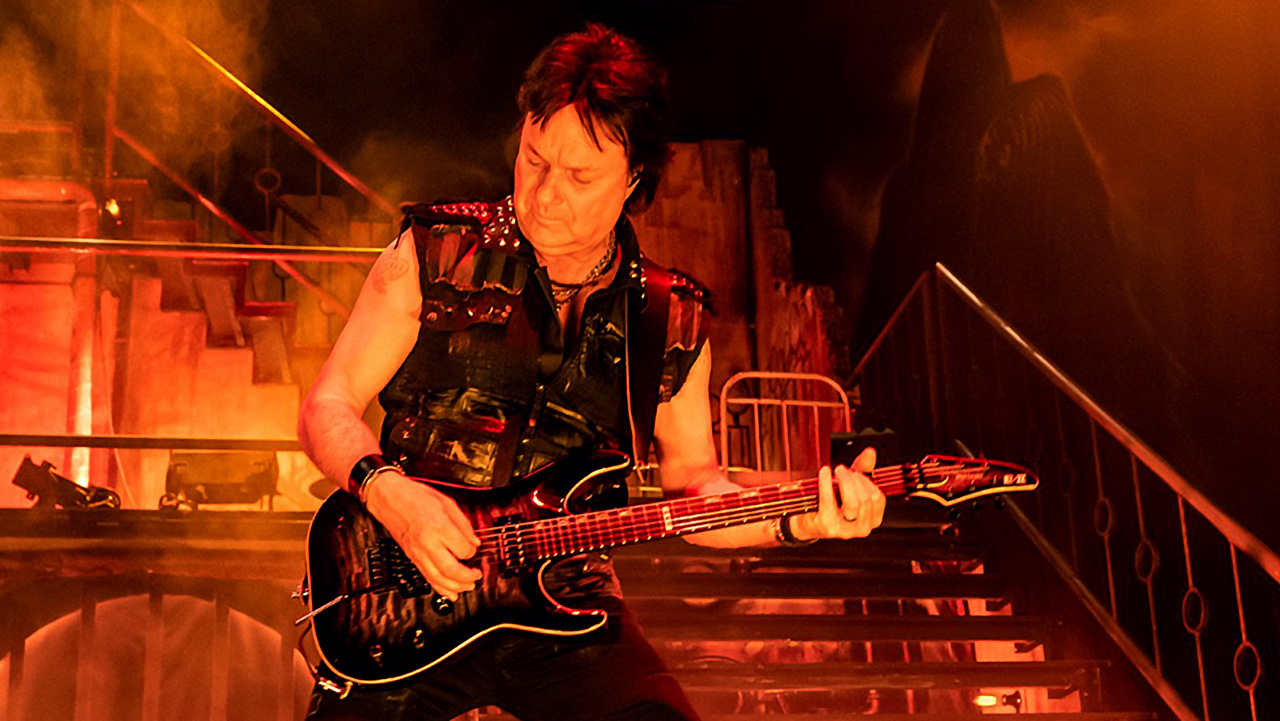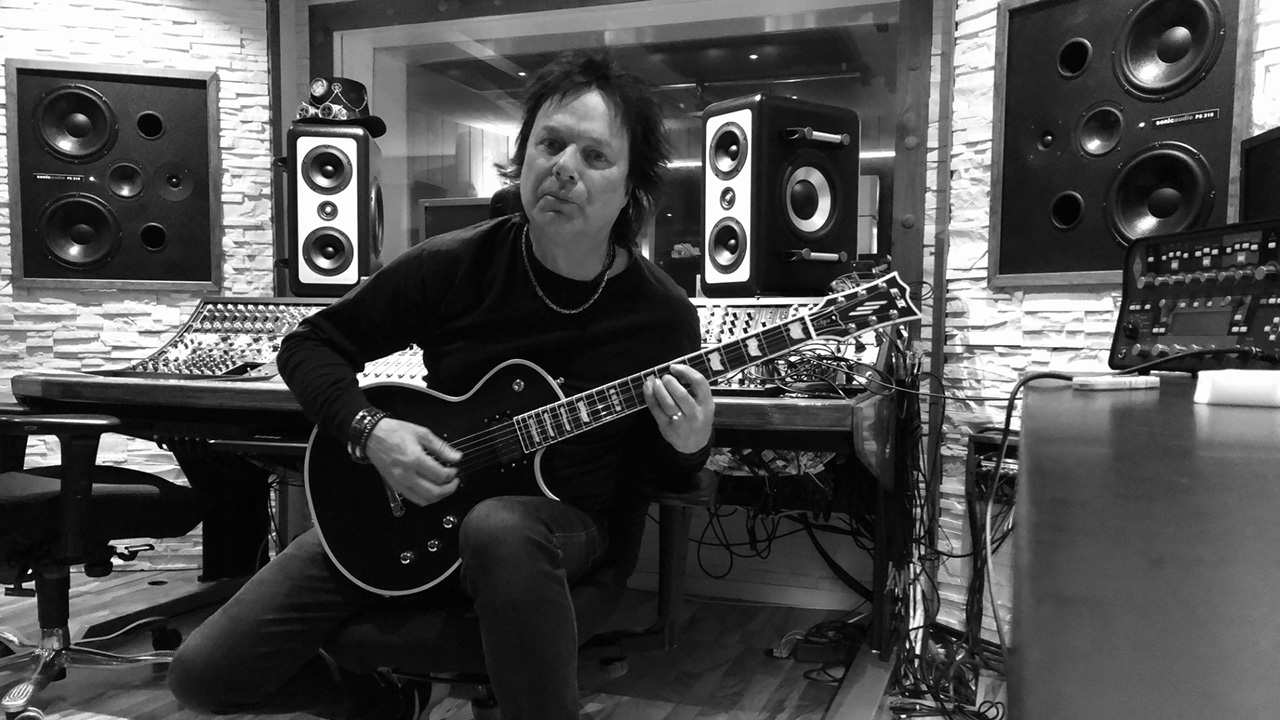
If you aren't careful, Andy LaRocque, best known for his neoclassical-inspired licks and sinful tone with King Diamond, can take your breath away. And that’s probably by design, given his muscular rock influences.
“I was very influenced by mid-‘70s music," LaRocque says. “I loved Uriah Heap and Status Quo. Those were the reasons that I picked up the guitar.
“I was very inspired by the guitar playing within glam rock like Sweet, Slade, and T. Rex, Later there was Michael Schenker, who has such amazing melodic sense, along with Randy Rhoads and Steve Vai.”
Given his ability to kick your teeth in and leave you smiling, it’s easy to lump LaRocque in with other ‘80s shredders. But his drenched-in-melodicism licks were outliers, and hinged on tone above all else.
LaRocque could shred with the best, but he came from a different place, eschewing theory and relying purely on instinct. “I don’t have a ton of theory knowledge,” he says. “I’m inspired by it, but I mostly use my ears to pick up on interesting things, which is what I did back then.
“So if people come up to me and say, ‘Why don’t you play this note or this scale?’ I honestly don’t know what they're specifically talking about. I play what sounds good. I skipped the whole music theory thing and focused on what was important to me.”
These days – along with his production work at his home studio, Sonic Train – LaRocque remains active with King Diamond, who are working on their first album since 2007’s Give Me Your Soul… Please. Their 13th release is rumored to be titled The Institute.
“We haven’t been out playing live for a couple of years,” LaRocque allows, “but we are working on new songs. I’ve sent King a bunch of songs, which are still demos. We’ve been working on those for a year and a half, and once that’s all done we’ll tour.
“That aside, I’m doing guest solos, so the songwriting and the riffing is still there. And, of course, I’ve got a lot of bands coming through here in the next few months. I still love doing that, and there's a lot coming up.”

What led to your joining King Diamond?
“I knew [original drummer] Mikkey Dee back in the early ‘80s. He’d moved down to Copenhagen in Denmark with a different band, then ended up in King Diamond. He called me one day saying, ‘Andy, we need a guitarist. You need to come down here, like now!’
“I was working at a music store in Gothenburg, Sweden, so I quit my job the day after, took my guitar and went to Copenhagen. That same day, I did the audition and played a song called Dressed in White from the first album [Fatal Portrait], and after that they said, ‘Welcome to the band!’”
What was your vision from a guitar perspective?
“When I first heard the music, I thought it was great because I had always been interested in darker, dramatic music with horror elements. I liked and was inspired by that neoclassical style, so I thought, ‘Oh, wow, this seems like a perfect combination of all those things.’”
Tell us how you developed your tone.
“I’ve always been a Marshall guy. Back then, I needed a bit of a boost, and I generally leaned on my Ibanez Tube Screamer [TS808], which I still think is one of the best pedals ever made. So, the Tube Screamer and the Marshall amps were just a great combination.
“And then, of course, you had to have good-sounding speakers, which I used a bunch of. I was always looking for a good lead tone; I wanted that warm feeling that could still cut through but had a lot of sustain, which is important when you play a lot of melodies.”
Many of the guitars you used early on were ones you built yourself, right?
“Yes. In fact, the guitar I brought with me when I went to Copenhagen that first time was a guitar I built myself. I was really into guitar building at the time – when I say ‘built myself’ I don't just mean assembling parts; I mean I cutting the wood out for the neck and body. As for the pickups, I had the same configuration as Randy Rhoads, where he had a Super Distortion in the bridge, and a PAF in the neck.
“That guitar followed me for many years, and I brought it on set to do a video for the song Welcome Home in 1988. During the shoot I broke one of the guitar’s wings, and it’s still like that. But after that I was endorsed by B.C. Rich, I tried EMG pickups, and I had a Floyd Rose tremolo – which I still have on all my live guitars.
That Floyd Rose was essential to your well-known whammy tricks, of course.
“Oh, yes, it was! It’s an amazing tremolo; many people have asked me about those tricks. It kind of sounds like a singing bird, which was just a matter of setting the Floyd Rose up the right way to get the right sustain and tone. But that, along with a good-sounding body, good pickups, and the Floyd Rose, were all huge parts of my sound.”

How did you end up working with Chuck Schuldiner on Death’s Individual Thought Patterns (1993)?
“Chuck had always been a big fan of King Diamond. He went to some of our concerts in the late ‘80s, so we'd met a couple of times. Chuck talked to the record company – Death were on the same label as King Diamond – and asked them to put him in touch with me. He told me he needed me to do solos for the album. And later he asked if I wanted to join the band.”
Why didn’t you?
“At the time, I was busy with everything else in my life; I had my kids and I was so busy. But I’ll say that the main challenge with Death was that it was very progressive – that's not to say that King Diamond wasn’t progressive, but the Death stuff really made me think twice. I added my type of melodies to it, but I did have to think twice to get it right.”
Did you use the same gear that you used with King Diamond?
“I probably used my B.C. Rich Gunslinger with Seymour Duncan JB pickups. And I asked them to rent me one of those Marshall Valvestate amps, which were very popular in the early ‘90s. I still have one; it’s not overly powerful, but the sound was controlled and perfect for my leads. That amp, again, with the Tube Screamer, was probably what I used on the Death album.”
What gear are you relying on these days?
“On the last King Diamond tour, I played Line 6 Helix rack-mounted guitar processors, Crown Power Amplifiers, Marshall 4x12 cabs with Celestion Vintage 30 speakers, and Sennheiser Wireless Systems. “
Do you still favor Marshall amps?
“Oh, yes. My favorite in the studio is a Marshall JVM 50-watt head, and I pair that with a ZUTA Duality Overdrive pedal. And I use Marshall or MUG 4X12 cabs with Celestion Vintage 30 speakers. But I also use Kemper with profiles that I've made of my favorite amps.”
And you're mostly ESP guitars now, right?
“Yes. For live guitars, I’m mainly using ESP E-II Horizon Strat-type guitars equipped with Seymour Duncan pickups and Floyd Rose tremolos. They’re Futone-modded, and I use Ernie Ball Super Slinky Paradigm 009-42 strings. In the studio, for composing and recording rhythm guitars, I use my ESP Eclipse, which is a Les Paul type, and my ESP Horizon.”

King Diamond and Death aside, you’ve been on dozens of sessions. Do you have a favorite?
“People always think I play super-fast, which is what you'd expect from a metal guitarist. But I would remind people that I’m very melodic, so I’ve done a lot of guest solos. It’s tough to pinpoint one that I’m incredibly proud of. But Rick Altzi, the vocalist of Masterplan, made a solo album [All Eyes on Me], and I played on that. A lot of people heard that and said, ‘I didn’t realize you could play that melodic; this is nice.’”
And of your King Diamond and Death output, is there a solo that best represents you?
“This one is easy: Welcome Home from the album Them (1988). I was inspired when I got into the studio – I had some new guitars and new amps, and I was on fire during that solo. Welcome Home turned out great! It combines the fast stuff with the melody, which is important. It sounds good to me still; I’ve always been happy with it.”
- The Institute is expected in early 2024 via Metal Blade. Find out more in due course at KingDiamondCoven.com.







